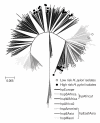Evolutionary History of the Helicobacter pylori Genome: Implications for Gastric Carcinogenesis - PubMed (original) (raw)
Evolutionary History of the Helicobacter pylori Genome: Implications for Gastric Carcinogenesis
Pelayo Correa et al. Gut Liver. 2012 Jan.
Abstract
The genome of the bacterium Helicobacter pylori has evolved over the millennia since its migration out of Africa along with its human host approximately 60,000 years ago. Human migrations, after thousands of years of permanent settlement in those lands, resulted in seven prototypes of genetic populations of H. pylori with distinct geographical distributions. In all continents, present day isolates of H. pylori have molecular markers that reflect population migrations. The colonization of the Americas as well as the slave trade introduced European and African strains to the New World. The relationship between H. pylori genome and gastric cancer rates is linked to the presence of the cagA gene, but the knowledge on this subject is incomplete because other genes may be involved in certain populations. A new situation for Homo sapiens is the absence of H. pylori colonization in certain, mostly affluent, populations, apparently brought about by improved home sanitation and widespread use of antibiotics during the last decades. The disappearance of H. pylori from the human microbiota may be linked to emerging epidemics of esophageal adenocarcinoma, some allergic diseases such as asthma and some autoimmune disorders.
Keywords: Gastric carcinogenesis; Genome; Helicobacter pylori.
Conflict of interest statement
No potential conflict of interest relevant to this article was reported.
Figures
Fig. 1
World map indicating human migrations (arrows) and time range in years since the migrations happened. H. pylori accompanied man during the migrations and the four major H. pylori populations (as known in 1999: Europe, Northern Asia, Southern Asia, and New Zealand) are represented by concentric circles of different colors. Light green areas indicate the locations where development of agriculture and animal breeding started, resulting in expansion of human populations (From Covacci A, et al. Science 1999;284:1328-1333, with permission).
Fig. 2
Phylogeography of H. pylori. Neighbor-joining tree of 64 _cagA_+ vacA s1m1 Colombian H. pylori isolates from the high-risk (black circles) and low-risk (open circles) regions, along with 380 reference strains that were previously classified into distinct ancestral haplogroups. Branches are drawn to scale to represent evolutionary distance. The colors of the branches represent the classification of strains into distinct populations (From de Sablet T, et al. Gut 2011;60:1189-1195, with permission).
Similar articles
- Helicobacter pylori from Peruvian amerindians: traces of human migrations in strains from remote Amazon, and genome sequence of an Amerind strain.
Kersulyte D, Kalia A, Gilman RH, Mendez M, Herrera P, Cabrera L, Velapatiño B, Balqui J, Paredes Puente de la Vega F, Rodriguez Ulloa CA, Cok J, Hooper CC, Dailide G, Tamma S, Berg DE. Kersulyte D, et al. PLoS One. 2010 Nov 29;5(11):e15076. doi: 10.1371/journal.pone.0015076. PLoS One. 2010. PMID: 21124785 Free PMC article. - A 500-year tale of co-evolution, adaptation, and virulence: Helicobacter pylori in the Americas.
Muñoz-Ramirez ZY, Pascoe B, Mendez-Tenorio A, Mourkas E, Sandoval-Motta S, Perez-Perez G, Morgan DR, Dominguez RL, Ortiz-Princz D, Cavazza ME, Rocha G, Queiroz DMM, Catalano M, Palma GZ, Goldman CG, Venegas A, Alarcon T, Oleastro M, Vale FF, Goodman KJ, Torres RC, Berthenet E, Hitchings MD, Blaser MJ, Sheppard SK, Thorell K, Torres J. Muñoz-Ramirez ZY, et al. ISME J. 2021 Jan;15(1):78-92. doi: 10.1038/s41396-020-00758-0. Epub 2020 Sep 2. ISME J. 2021. PMID: 32879462 Free PMC article. - Helicobacter pylori Sequences Reflect Past Human Migrations.
Moodley Y, Linz B. Moodley Y, et al. Genome Dyn. 2009;6:62-74. doi: 10.1159/000235763. Epub 2009 Aug 19. Genome Dyn. 2009. PMID: 19696494 - The Story of Helicobacter pylori: Depicting Human Migrations from the Phylogeography.
Waskito LA, Yamaoka Y. Waskito LA, et al. Adv Exp Med Biol. 2019;1149:1-16. doi: 10.1007/5584_2019_356. Adv Exp Med Biol. 2019. PMID: 31016625 Review. - Pathogenomics of Helicobacter pylori.
Yamaoka Y, Saruuljavkhlan B, Alfaray RI, Linz B. Yamaoka Y, et al. Curr Top Microbiol Immunol. 2023;444:117-155. doi: 10.1007/978-3-031-47331-9_5. Curr Top Microbiol Immunol. 2023. PMID: 38231217 Review.
Cited by
- Resolving the etiology of atopic disorders by using genetic analysis of racial ancestry.
Gupta J, Johansson E, Bernstein JA, Chakraborty R, Khurana Hershey GK, Rothenberg ME, Mersha TB. Gupta J, et al. J Allergy Clin Immunol. 2016 Sep;138(3):676-699. doi: 10.1016/j.jaci.2016.02.045. Epub 2016 Jun 11. J Allergy Clin Immunol. 2016. PMID: 27297995 Free PMC article. Review. - Relatedness of Helicobacter pylori populations to gastric carcinogenesis.
Dong QJ, Zhan SH, Wang LL, Xin YN, Jiang M, Xuan SY. Dong QJ, et al. World J Gastroenterol. 2012 Dec 7;18(45):6571-6. doi: 10.3748/wjg.v18.i45.6571. World J Gastroenterol. 2012. PMID: 23236231 Free PMC article. Review. - Risk Factors Analysis and Prediction Model Establishment of Intestinal Metaplasia or Dysplasia in Patients With Chronic Atrophic Gastritis: A Multi-Center Retrospective Study.
Pei B, Wen Z, Yang Q, Wang J, Cao Q, Dai L, Li X. Pei B, et al. Front Med (Lausanne). 2022 May 18;9:912331. doi: 10.3389/fmed.2022.912331. eCollection 2022. Front Med (Lausanne). 2022. PMID: 35665336 Free PMC article. - Global Trend on Machine Learning in Helicobacter within One Decade: A Scientometric Study.
Eslami O, Nakhaie M, Rezaei Zadeh Rukerd M, Azimi M, Shahabi E, Honarmand A, Khazaneha M. Eslami O, et al. Glob Health Epidemiol Genom. 2023 Aug 12;2023:8856736. doi: 10.1155/2023/8856736. eCollection 2023. Glob Health Epidemiol Genom. 2023. PMID: 37600599 Free PMC article. - Role of TNF-α-Inducing Protein Secreted by Helicobacter pylori as a Tumor Promoter in Gastric Cancer and Emerging Preventive Strategies.
Suganuma M, Watanabe T, Sueoka E, Lim IK, Fujiki H. Suganuma M, et al. Toxins (Basel). 2021 Mar 1;13(3):181. doi: 10.3390/toxins13030181. Toxins (Basel). 2021. PMID: 33804551 Free PMC article. Review.
References
- Peek RM, Jr, Crabtree JE. Helicobacter infection and gastric neoplasia. J Pathol. 2006;208:233–248. - PubMed
- Uemura N, Okamoto S, Yamamoto S, et al. Helicobacter pylori infection and the development of gastric cancer. N Engl J Med. 2001;345:784–789. - PubMed
LinkOut - more resources
Full Text Sources

